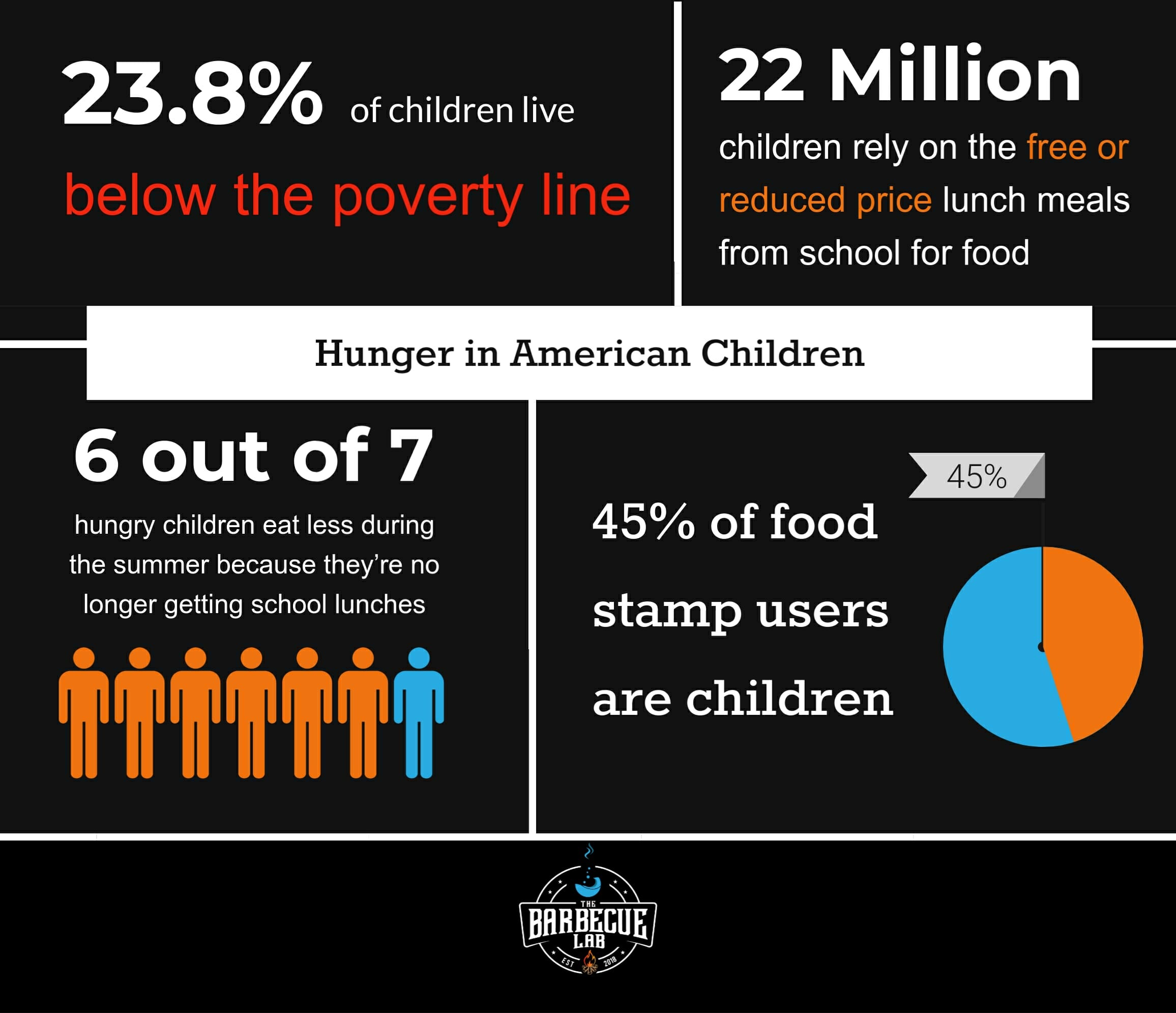Hunger in America Statistics
(Updated July 2025)
Hunger and food insecurity are real issues for some American families. With a total population of approximately 330 million people, roughly 12% are food insecure. They do not have reliable, steady access to food. In this article, we will dive in and look at specific statistics regarding hunger in the United States including:
Quick Hunger Statistics
Most American Households do not struggle with having reliable access to food. According to statistics from the United States Department of Agriculture (USDA), 88.9% of American households are considered food secure.
What percentage of the US is hungry?
Hunger is a very real issue for 12% or 41 million people in the United States. Hunger is the distress that comes from not having enough food. Having inadequate intake of nutritious food & calories can lead to a multitude of other problems, including health decline, developmental delays, behavioral issues, and decreased productivity.
41 million people struggle with hunger in the United States.
Is there a hunger problem in the United States?
Chronic hunger is directly correlated with the number of Americans living at or below the poverty line. In 2019, the poverty line for a family of 4 was $25,750. In 2019, it’s estimated that the United States had 38 million people living in poverty.
Who’s mostly affected by hunger?
If children are struggling with hunger, then they are coming from families who are likely struggling as well. Children and adults make up 90% of those who battle hunger and undernourishment, while seniors make up the remaining 10%.

At least 84% of the people over the age of 65 have at least one chronic medical condition. In addition, around 14.1% of the senior citizens in America fall below the poverty line. This means many seniors must choose between paying for food or paying for medication. Healthcare costs and out-of-pocket expenses are ever increasing, making the struggle to make ends meet that much more difficult.
Children and Hunger in america
Child hunger is also a real issue in America. It’s estimated that 16.7% of children do not know where their next meal is coming from. Around 22 million school age children rely on the free or reduced lunch program from school for food. Many schools offer the School Breakfast Program to help offset the cost of these meals for these hungry students.

Teachers take notice, too. When students don’t have enough quality caloric intake, there may be developmental or cognitive delays. They also may not be able to focus and exhibit behavioral problems. While hunger is a complex topic, 62% of school teachers say that that least one child in their classes come to school hungry.
Almost a quarter of American children are living below the poverty line. 23.8% of children are considered part of low-income households. Of the people that benefit from supplemental food assistance programs like SNAP and WIC, 45% of them are children.
Many children eat less during the summer or on break from school. It’s estimated that 6 out of 7 hungry children will eat less during the summer because they aren’t getting school lunches. That’s 86% of hungry kids.
Hunger and Poverty
In America, the poverty line varies depending on the number of dependents, but to give us a starting point, let’s use an annual income of $25,750 or less for a family of 4.
Poverty directly correlates with hunger. According to the Food and Research Access Center, the poverty rate is much higher for African Americans and Hispanics than it is for whites.

The supplemental nutrition assistance program (SNAP) and the program for women, infants and children (WIC) help offset some of the cost of food to help families get out of poverty. Other benefits like tax credits & social security programs also help move families out of poverty.
Thankfully, the poverty rate in America is decreasing. In 2018, the poverty rate was 11.8%, down from 14.8% in 2014.

Government Aid to help hunger in america
According to the USDA, about 1 in 4 Americans take advantage of at least one of the food supplement programs at some point in any given year. To families that qualify, there are several government programs that help with the cost of food.
There are 45 million total Americans living in 13.76 million households that currently rely on government aid for food, which is down from 15.49 million in 2014. This includes the Supplemental Nutrition Assistance Program (SNAP), formerly known as food stamps, the National School Lunch Program, and Women, Infants & Children, and others.

Whether an individual or family qualifies for assistance will depend on their home state, so look at your local state’s website for more information. In general, a family of 4 living in the continental United States will qualify for assistance if they make less than or equal to a gross monthly income of $2,720 or a net income of $2,146. But the average monthly income of people who use government aid is $813/month.

Food Insecurity
Having reliable steady access to food doesn’t only happen to those who are unemployed. Of those that are employed, many still don’t make enough money to make ends meet. Around 1 in 10 working adults are experiencing very low food security. Proponents of increased minimum wage policies note that there are less food insecure working adults in areas where the minimum wage is higher than the national average.

All types of households experience food insecurity - households with children, without children, people living alone, single parent households. On average, food insecure households are currently on a downward trend in the United States and is currently at 11.07%. .

In the following stats, these types of households had a higher prevalence of food insecurity than the national average of around 11%. Houses with children headed by a single woman is the type of household with the highest prevalence of food insecurity.
Houses with children headed by a single woman | Black households | Hispanic households | Houses with children headed by a single man |
|---|---|---|---|
27.8%
Fill Counter
| 21.2%
Fill Counter
| 16.2%
Fill Counter
| 15.9%
Fill Counter
|
Houses with children under 6 years of age | Women living alone | All houses with children | Men living alone |
|---|---|---|---|
14.3%
Fill Counter
| 14.2%
Fill Counter
| 13.9%
Fill Counter
| 12.5%
Fill Counter
|
Where are hunger and food insecurity most prevalent in the united states?
What is the hungriest state in America? We can see the top 10 states that have houses that struggle with hunger in the chart below. In New Mexico, Mississippi, Louisiana, West Virginia and Oklahoma have 1 in 6 houses struggle to feed their household.
In Arkansas, Alabama, Kentucky, Texas, and North Carolina, 1 in 7 houses struggle to feed their household.

What state has the highest rate of food insecurity?
The state with the highest prevalence of food insecurity - or the percentage of the population that struggles with not having reliable access to good, nutritious foods - is the state of Mississippi at 18.7%.

Food Deserts
There are currently 23.5 million Americans who live in what is called a food desert.
Two variables that can contribute to a food desert are a person’s geographic location and access to reliable transportation. In fact, 4.2 % of Americans don’t have a vehicle and live more than a half mile away from a grocery store. They might have access to processed, low quality food at the local convenience store or gas station. But that type of food is not considered sustainable.
They might live in an urban area that has access to good nutritious food, but they might simply lack the funds to be able to purchase it.
Some people live in places where they do not have easy access to a grocery store, especially in rural states like Wyoming and Nevada. 15% of people who live in rural areas struggle with hunger.

Food Banks
There are now more than 200 food banks in America which supply enough food for 63,000 food pantries and shelters in the United States. This is up from around 24 in 1980. However, even despite the increase in food pantry options and shelters, food security has not been achieved. Food insecurity has remained unchanged in the past few years.
There are now more than 200 food banks in America which supply food for 63,000 food pantries and shelters in the United States.
The issue of chronic hunger is a result of the much larger issue of poverty. Hopefully, Americans will soon find a solution to help serve our neighbors so that they do not have to suffer needlessly in this land of abundance.
Hunger in America Statistics
Resources and Downloads
Data Sources
